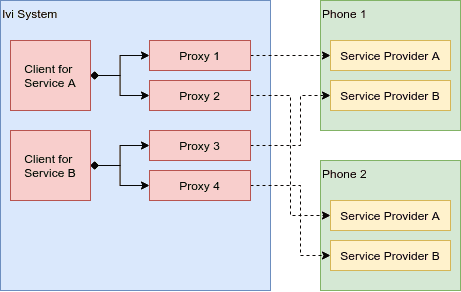Companion Application
Important note:The TomTom Digital Cockpit SDK is not available for general use. Please contact us for more information.
A companion application runs on the user's phone to extend the TomTom Digital Cockpit platform experience with functionality that is available on that phone; for example, to capture message notifications, calendar events, or other data on the phone, and pass them to the IVI system. Or sharing locations on the phone, as a navigation destination for the IVI system.
Overview
The TomTom Digital Cockpit platform provides a framework which allows data communication with companion apps via services which can be extended for different kind of purposes.
A Bluetooth Low Energy (BLE) connection is used to connect companion apps with the IVI system. On top of which we provide a high-level service oriented framework that can be easily extended with custom services.
Services are defined using Protobuf service definitions and can contain remote procedure calls as well as live data properties that can be observed.
The companion app will provide services and thus can be seen as the server side. The IVI side can call into those services and can therefore be seen as the client side.
We therefore call the companion app side of a service the Service Provider and the IVI side the Client.
Multiple companion apps can be connected at the same time, which means that there can be multiple connections from the IVI system to companion apps for a single service. Each service only has one client on the IVI side, but that client can spawn multiple service proxies; one to each companion app. Vice versa, a companion app can only be connected to one IVI system at a time, therefore there is always a maximum of one client connected to a service provider from the view of the companion app.

Service interfaces are described using Protobuf files. These are used to generate classes that can be directly integrated into the IVI system and the companion app.
- Stub classes are generated for the companion side, that can be implemented to provide the service functionality.
- Proxy classes are generated for the IVI side, that can be called into directly. All calls into the proxy classes will be directly forwarded to the companion app. All observed properties will be automatically updated when their data changes on the companion app side.
Because a service definition is used by both the IVI system and the companion app, it is necessary to put the service definition in a library that can be imported by both.
More information
For more information please reach out to your TomTom representative.